coolant level JEEP WRANGLER 2014 JK / 3.G Owners Manual
[x] Cancel search | Manufacturer: JEEP, Model Year: 2014, Model line: WRANGLER, Model: JEEP WRANGLER 2014 JK / 3.GPages: 678, PDF Size: 4.97 MB
Page 412 of 678
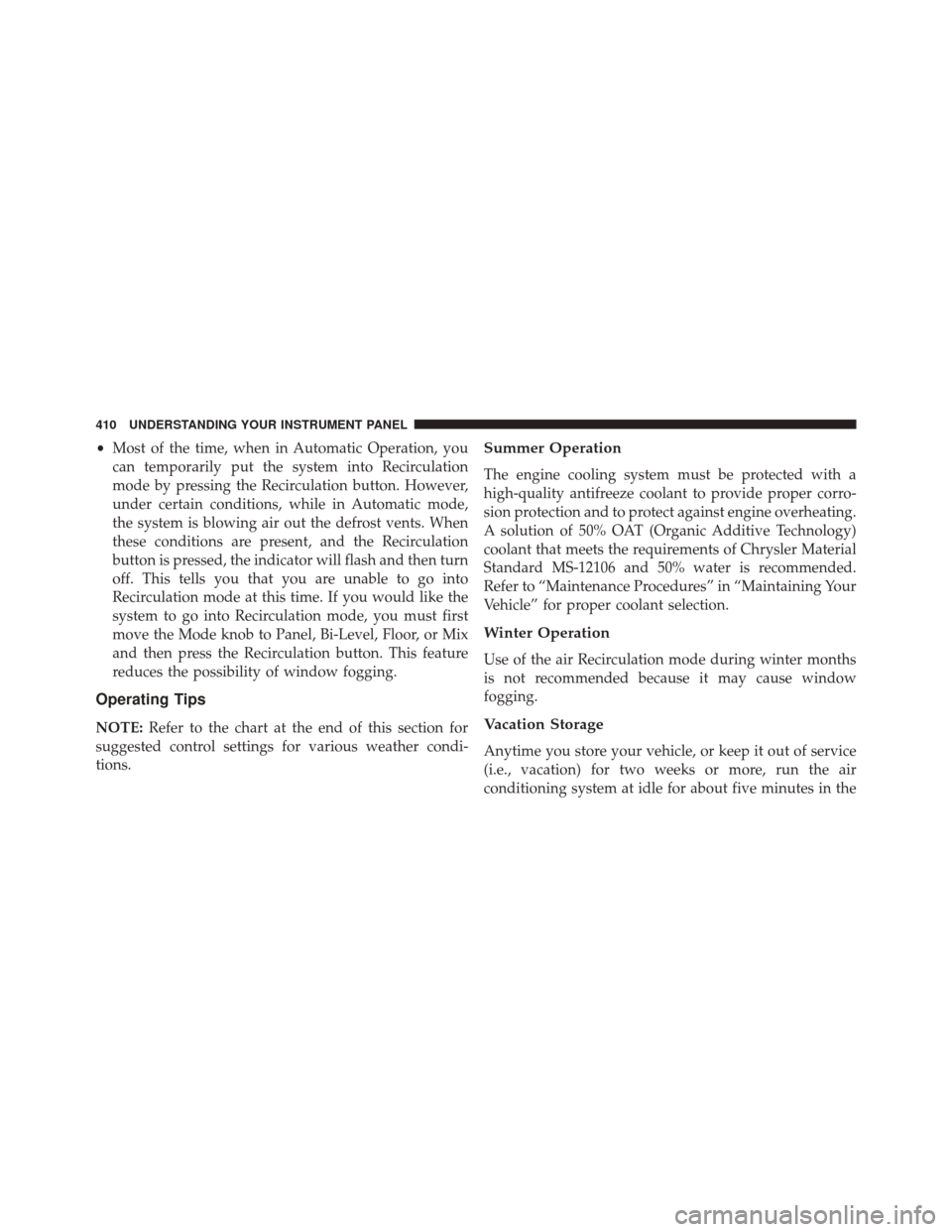
•Most of the time, when in Automatic Operation, you
can temporarily put the system into Recirculation
mode by pressing the Recirculation button. However,
under certain conditions, while in Automatic mode,
the system is blowing air out the defrost vents. When
these conditions are present, and the Recirculation
button is pressed, the indicator will flash and then turn
off. This tells you that you are unable to go into
Recirculation mode at this time. If you would like the
system to go into Recirculation mode, you must first
move the Mode knob to Panel, Bi-Level, Floor, or Mix
and then press the Recirculation button. This feature
reduces the possibility of window fogging.
Operating Tips
NOTE: Refer to the chart at the end of this section for
suggested control settings for various weather condi-
tions.
Summer Operation
The engine cooling system must be protected with a
high-quality antifreeze coolant to provide proper corro-
sion protection and to protect against engine overheating.
A solution of 50% OAT (Organic Additive Technology)
coolant that meets the requirements of Chrysler Material
Standard MS-12106 and 50% water is recommended.
Refer to “Maintenance Procedures” in “Maintaining Your
Vehicle” for proper coolant selection.
Winter Operation
Use of the air Recirculation mode during winter months
is not recommended because it may cause window
fogging.
Vacation Storage
Anytime you store your vehicle, or keep it out of service
(i.e., vacation) for two weeks or more, run the air
conditioning system at idle for about five minutes in the
410 UNDERSTANDING YOUR INSTRUMENT PANEL
Page 602 of 678
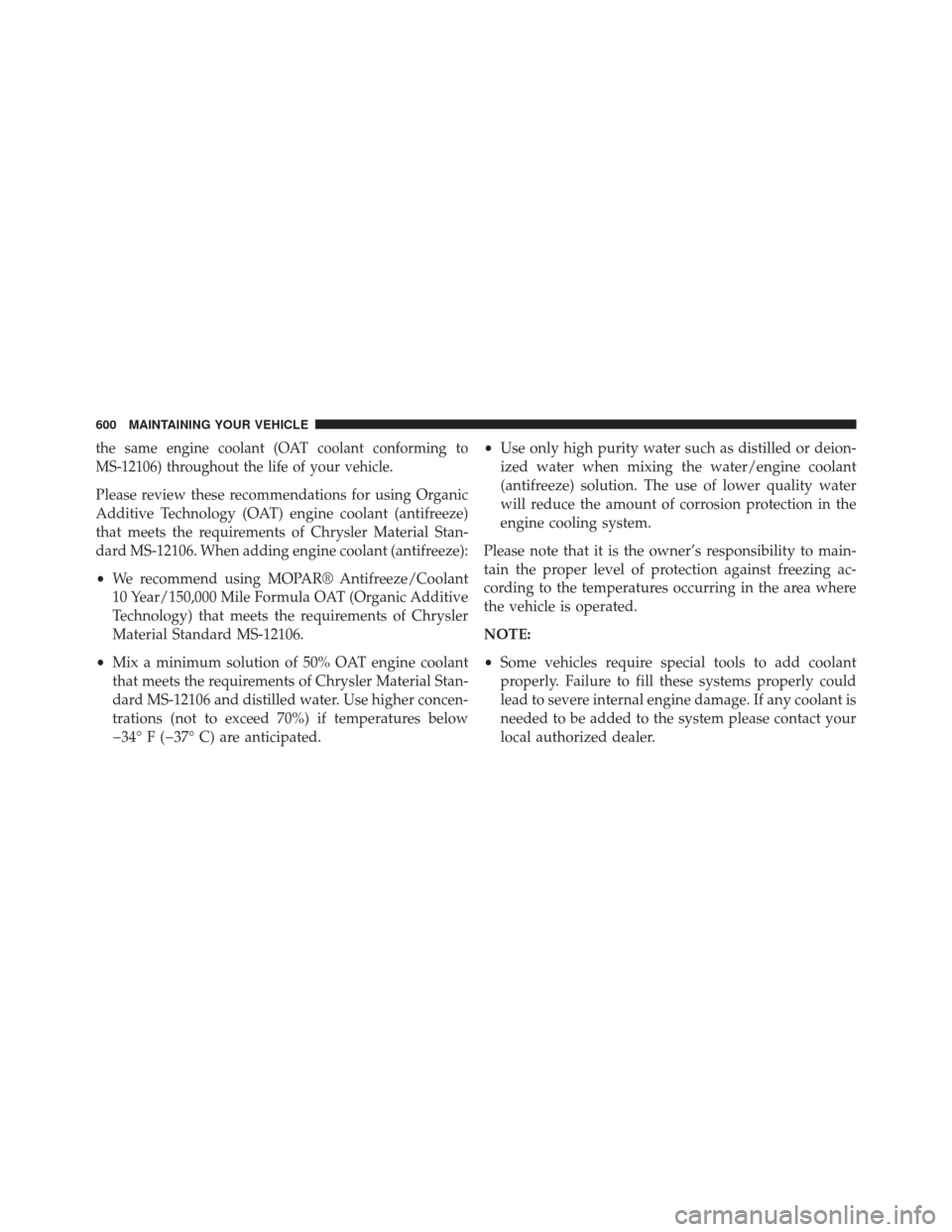
the same engine coolant (OAT coolant conforming to
MS-12106) throughout the life of your vehicle.
Please review these recommendations for using Organic
Additive Technology (OAT) engine coolant (antifreeze)
that meets the requirements of Chrysler Material Stan-
dard MS-12106. When adding engine coolant (antifreeze):
•We recommend using MOPAR® Antifreeze/Coolant
10 Year/150,000 Mile Formula OAT (Organic Additive
Technology) that meets the requirements of Chrysler
Material Standard MS-12106.
• Mix a minimum solution of 50% OAT engine coolant
that meets the requirements of Chrysler Material Stan-
dard MS-12106 and distilled water. Use higher concen-
trations (not to exceed 70%) if temperatures below
�34° F (�37° C) are anticipated. •
Use only high purity water such as distilled or deion-
ized water when mixing the water/engine coolant
(antifreeze) solution. The use of lower quality water
will reduce the amount of corrosion protection in the
engine cooling system.
Please note that it is the owner’s responsibility to main-
tain the proper level of protection against freezing ac-
cording to the temperatures occurring in the area where
the vehicle is operated.
NOTE:
• Some vehicles require special tools to add coolant
properly. Failure to fill these systems properly could
lead to severe internal engine damage. If any coolant is
needed to be added to the system please contact your
local authorized dealer.
600 MAINTAINING YOUR VEHICLE
Page 604 of 678
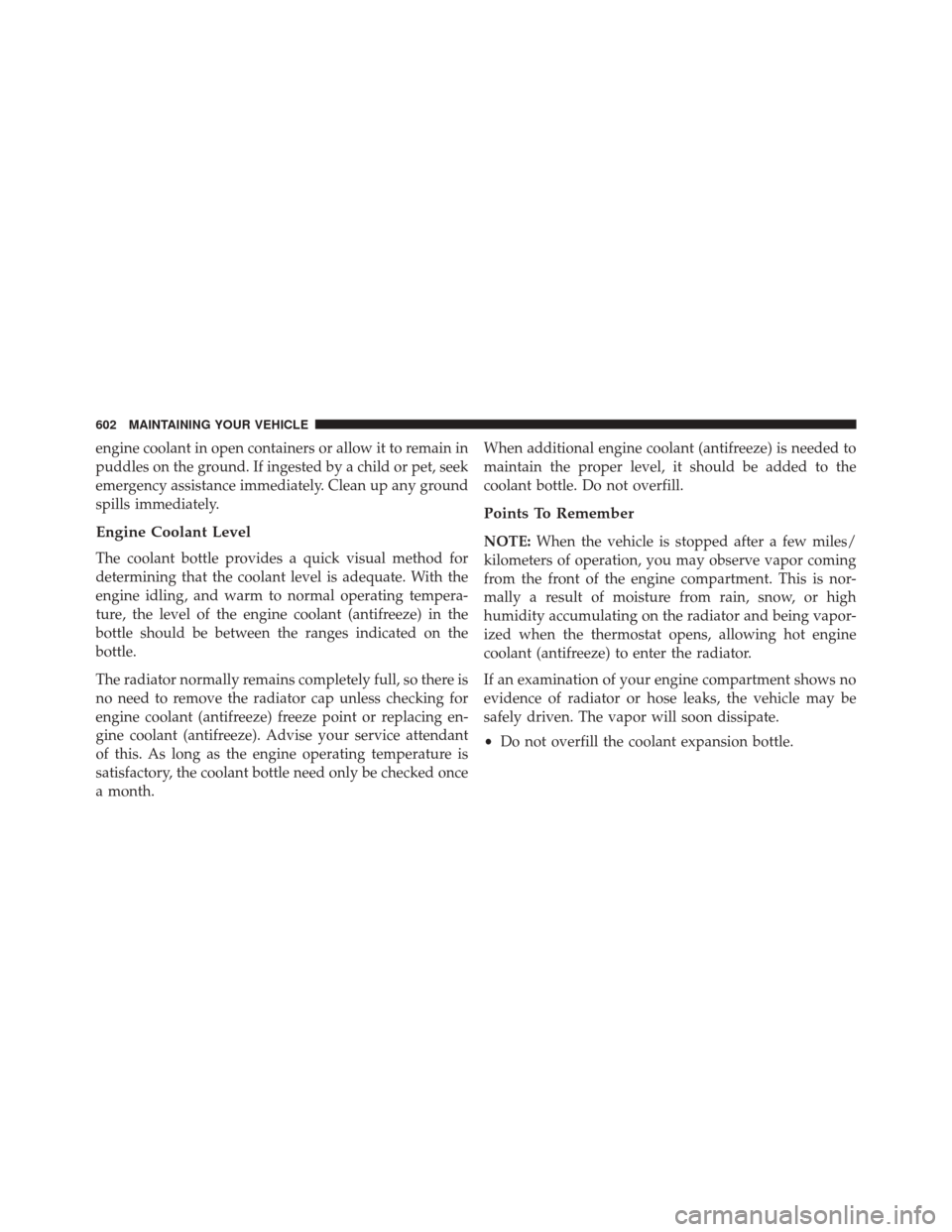
engine coolant in open containers or allow it to remain in
puddles on the ground. If ingested by a child or pet, seek
emergency assistance immediately. Clean up any ground
spills immediately.
Engine Coolant Level
The coolant bottle provides a quick visual method for
determining that the coolant level is adequate. With the
engine idling, and warm to normal operating tempera-
ture, the level of the engine coolant (antifreeze) in the
bottle should be between the ranges indicated on the
bottle.
The radiator normally remains completely full, so there is
no need to remove the radiator cap unless checking for
engine coolant (antifreeze) freeze point or replacing en-
gine coolant (antifreeze). Advise your service attendant
of this. As long as the engine operating temperature is
satisfactory, the coolant bottle need only be checked once
a month.When additional engine coolant (antifreeze) is needed to
maintain the proper level, it should be added to the
coolant bottle. Do not overfill.
Points To Remember
NOTE:
When the vehicle is stopped after a few miles/
kilometers of operation, you may observe vapor coming
from the front of the engine compartment. This is nor-
mally a result of moisture from rain, snow, or high
humidity accumulating on the radiator and being vapor-
ized when the thermostat opens, allowing hot engine
coolant (antifreeze) to enter the radiator.
If an examination of your engine compartment shows no
evidence of radiator or hose leaks, the vehicle may be
safely driven. The vapor will soon dissipate.
• Do not overfill the coolant expansion bottle.
602 MAINTAINING YOUR VEHICLE
Page 634 of 678
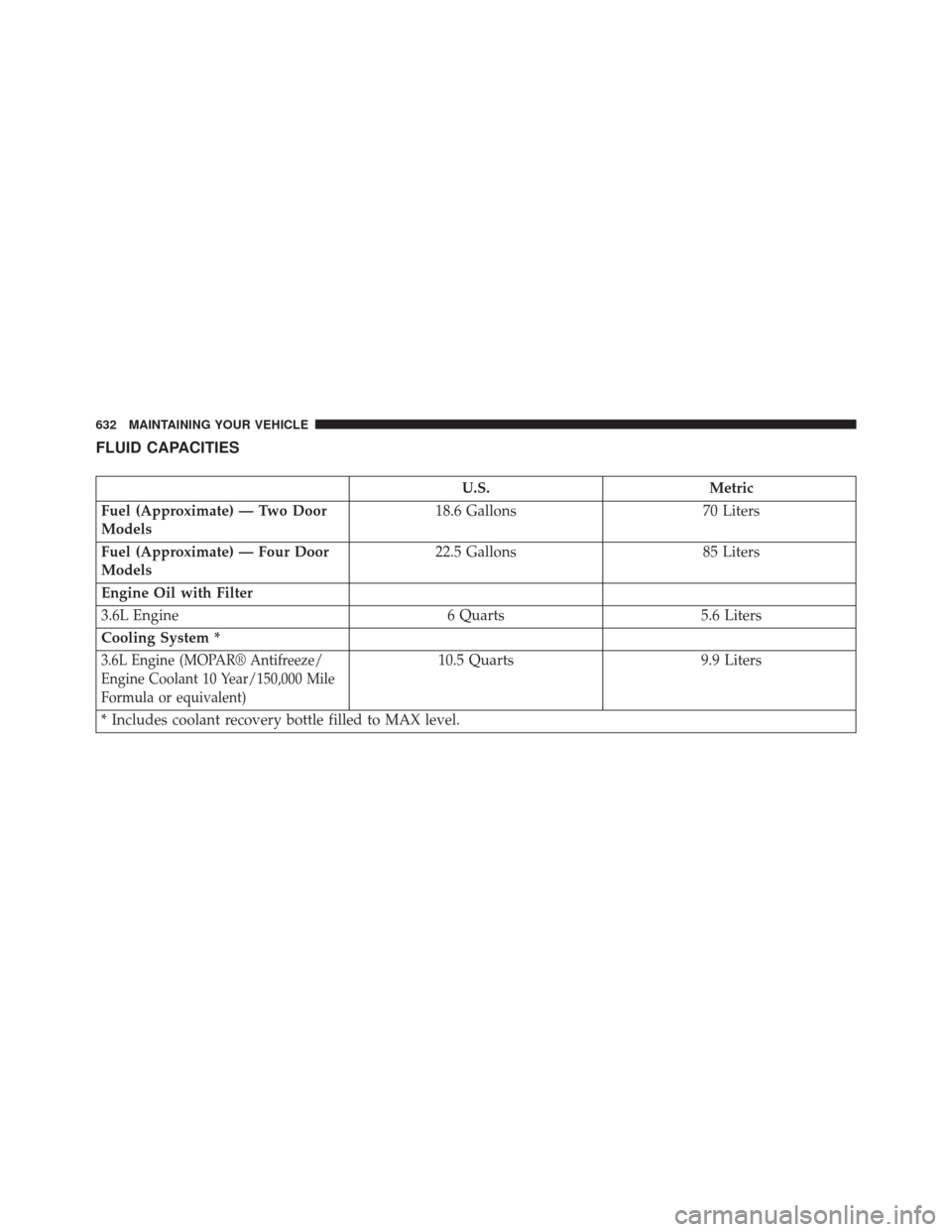
FLUID CAPACITIES
U.S.Metric
Fuel (Approximate) — Two Door
Models 18.6 Gallons
70 Liters
Fuel (Approximate) — Four Door
Models 22.5 Gallons
85 Liters
Engine Oil with Filter
3.6L Engine 6 Quarts5.6 Liters
Cooling System *
3.6L Engine (MOPAR® Antifreeze/
Engine Coolant 10 Year/150,000 Mile
Formula or equivalent)10.5 Quarts 9.9 Liters
* Includes coolant recovery bottle filled to MAX level.
632 MAINTAINING YOUR VEHICLE
Page 639 of 678
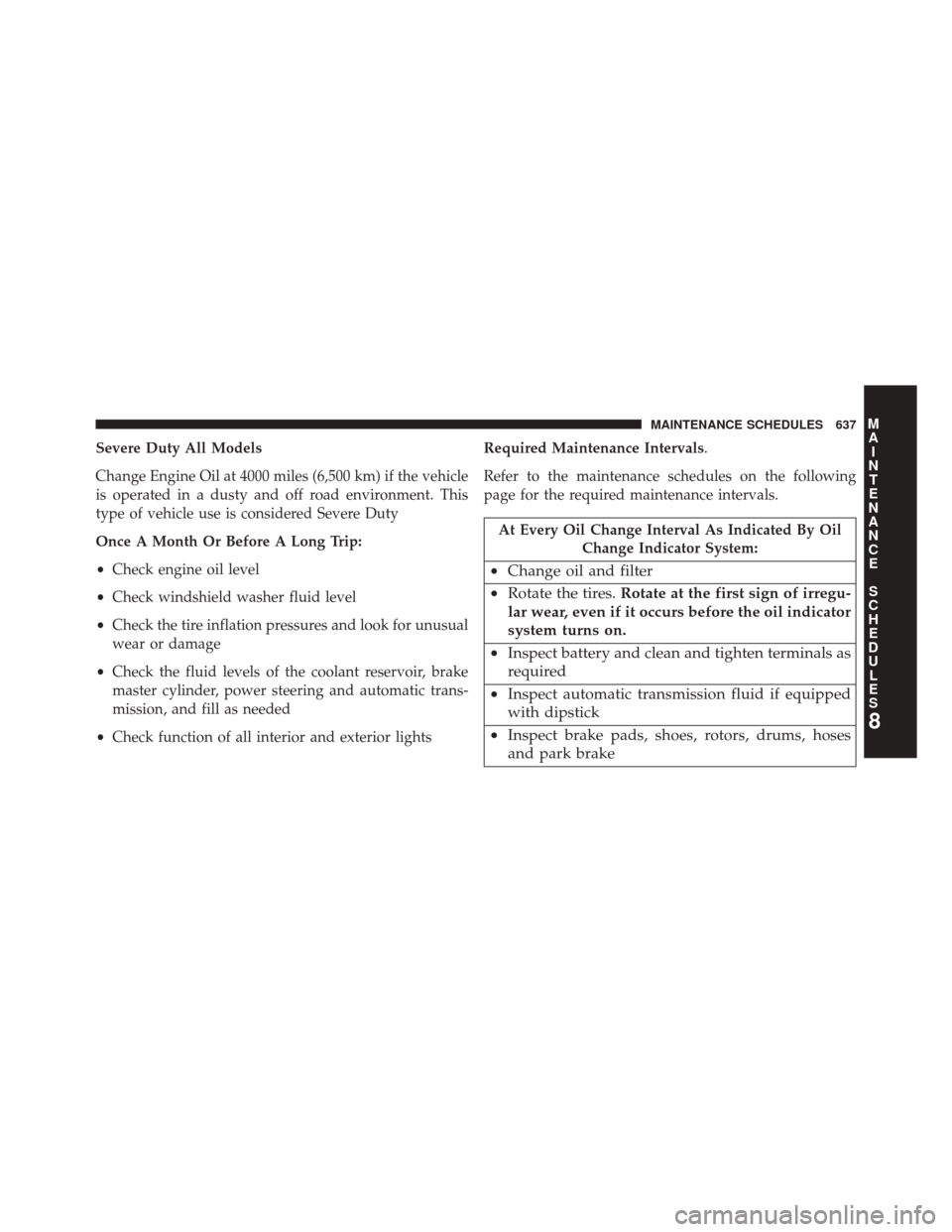
Severe Duty All Models
Change Engine Oil at 4000 miles (6,500 km) if the vehicle
is operated in a dusty and off road environment. This
type of vehicle use is considered Severe Duty
Once A Month Or Before A Long Trip:
•Check engine oil level
• Check windshield washer fluid level
• Check the tire inflation pressures and look for unusual
wear or damage
• Check the fluid levels of the coolant reservoir, brake
master cylinder, power steering and automatic trans-
mission, and fill as needed
• Check function of all interior and exterior lights Required Maintenance Intervals.
Refer to the maintenance schedules on the following
page for the required maintenance intervals.
At Every Oil Change Interval As Indicated By Oil
Change Indicator System:
•Change oil and filter
• Rotate the tires. Rotate at the first sign of irregu-
lar wear, even if it occurs before the oil indicator
system turns on.
• Inspect battery and clean and tighten terminals as
required
• Inspect automatic transmission fluid if equipped
with dipstick
• Inspect brake pads, shoes, rotors, drums, hoses
and park brake
8
M
A I
N T
E
N
A
N
C E
S
C
H E
D
U L
E
SMAINTENANCE SCHEDULES 637
Page 659 of 678
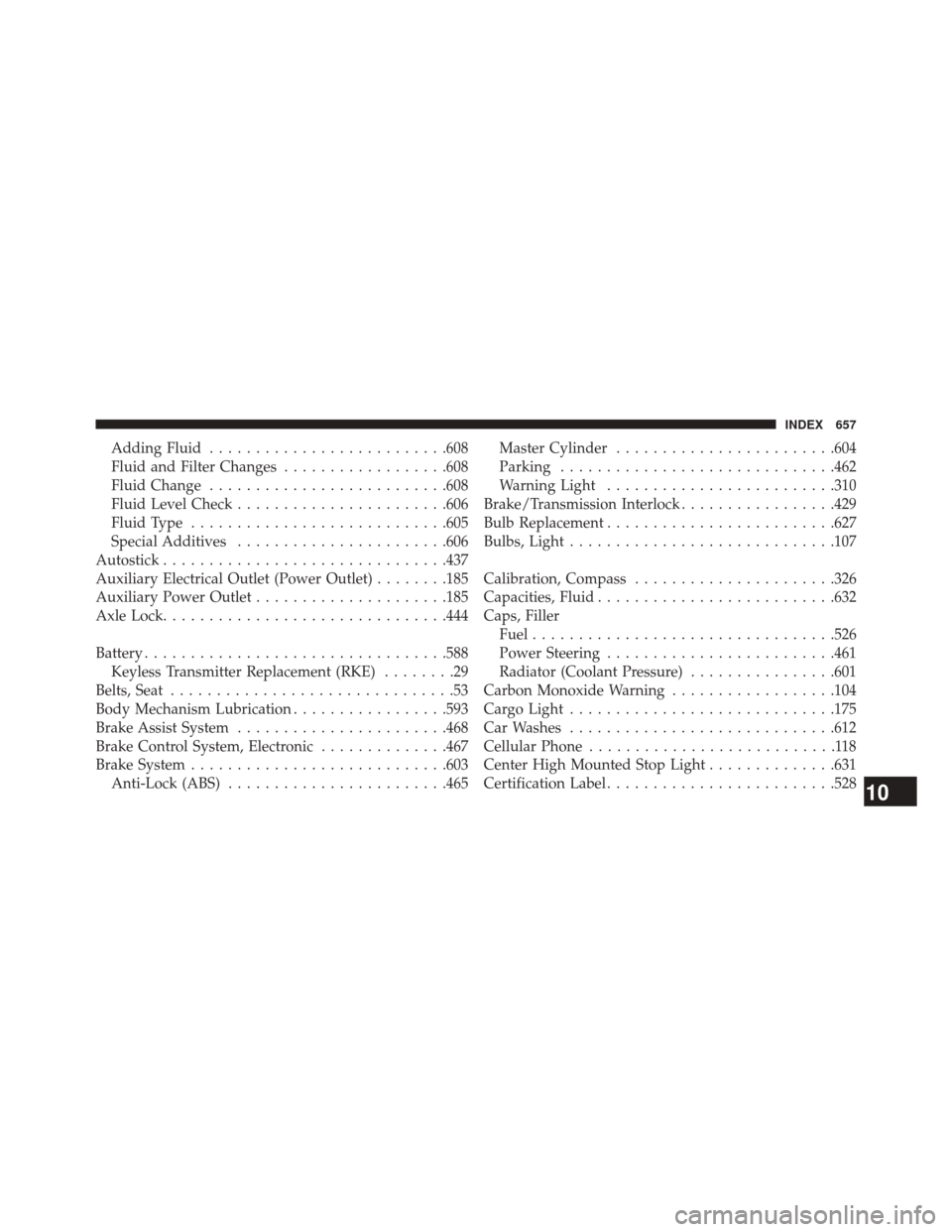
Adding Fluid......................... .608
Fluid and Filter Changes ..................608
Fluid Change ......................... .608
Fluid Level Check ...................... .606
Fluid Type ........................... .605
Special Additives ...................... .606
Autostick .............................. .437
Auxiliary Electrical Outlet (Power Outlet) ........185
Auxiliary Power Outlet .....................185
Axle Lock .............................. .444
Battery ................................ .588
Keyless Transmitter Replacement (RKE) ........29
Belts, Seat ...............................53
Body Mechanism Lubrication .................593
Brake Assist System ...................... .468
Brake Control System, Electronic ..............467
Brake System ........................... .603
Anti-Lock (ABS) ....................... .465Master Cylinder
....................... .604
Parking ............................. .462
Warning Light ........................ .310
Brake/Transmission Interlock .................429
Bulb Replacement ........................ .627
Bulbs, Light ............................ .107
Calibration, Compass ..................... .326
Capacities, Fluid ......................... .632
Caps, Filler Fuel ................................ .526
Power Steering ........................ .461
Radiator (Coolant Pressure) ................601
Carbon Monoxide Warning ..................104
Cargo Light ............................ .175
Car Washes ............................ .612
Cellular Phone ...........................118
Center High Mounted Stop Light ..............631
Certification Label ........................ .528
10
INDEX 657
Page 660 of 678
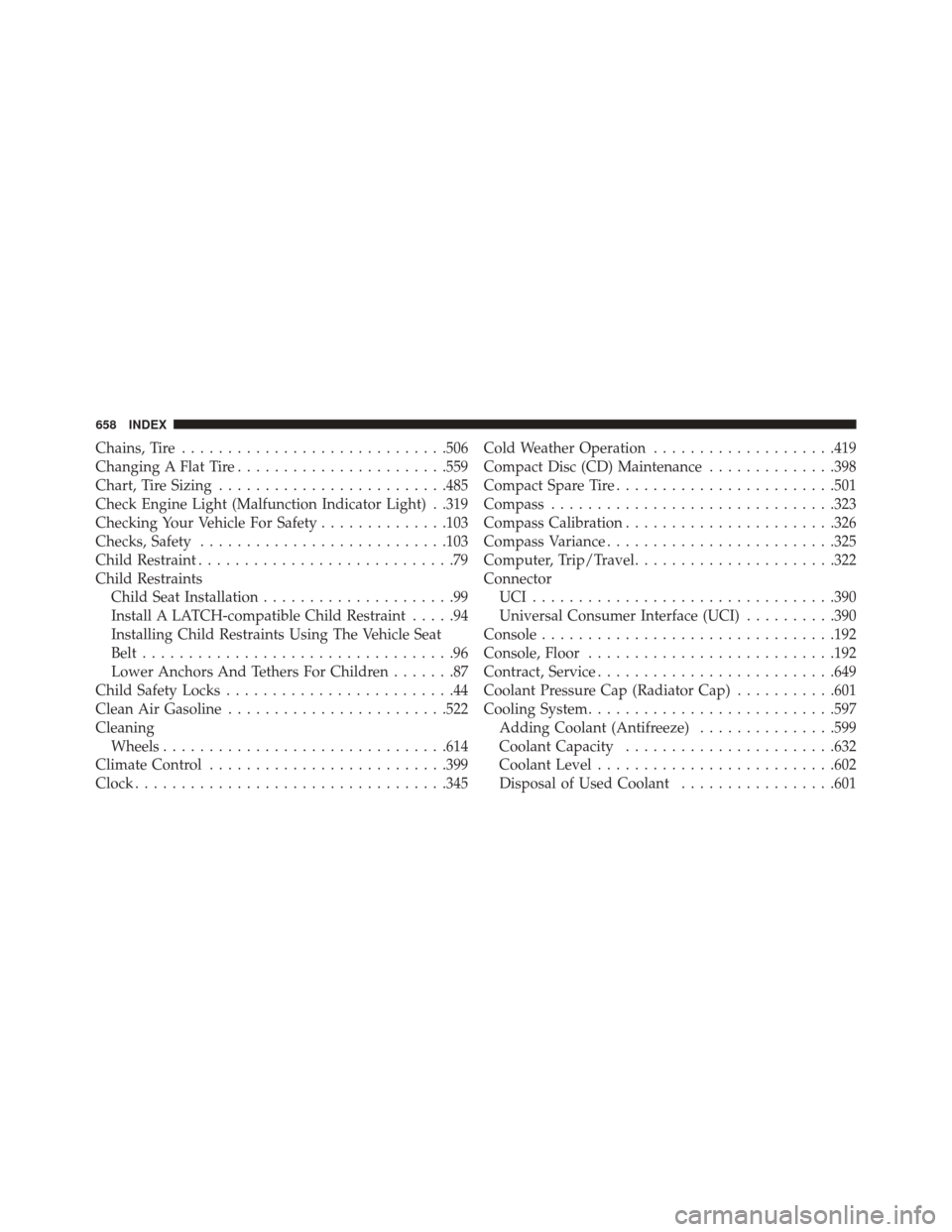
Chains, Tire............................ .506
Changing A Flat Tire ...................... .559
Chart, Tire Sizing ........................ .485
Check Engine Light (Malfunction Indicator Light) . .319
Checking Your Vehicle For Safety ..............103
Checks, Safety .......................... .103
Child Restraint ............................79
Child Restraints Child Seat Installation .....................99
Install A LATCH-compatible Child Restraint .....94
Installing Child Restraints Using The Vehicle Seat
Belt ..................................96
Lower Anchors And Tethers For Children .......87
Child Safety Locks .........................44
Clean Air Gasoline ....................... .522
Cleaning Wheels .............................. .614
Climate Control ......................... .399
Clock ................................. .345Cold Weather Operation
....................419
Compact Disc (CD) Maintenance ..............398
Compact Spare Tire ....................... .501
Compass .............................. .323
Compass Calibration ...................... .326
Compass Variance ........................ .325
Computer, Trip/Travel ..................... .322
Connector UCI................................ .390
Universal Consumer Interface (UCI) ..........390
Console ............................... .192
Console, Floor .......................... .192
Contract, Service ......................... .649
Coolant Pressure Cap (Radiator Cap) ...........601
Cooling System .......................... .597
Adding Coolant (Antifreeze) ...............599
Coolant Capacity ...................... .632
Coolant Level ......................... .602
Disposal of Used Coolant .................601
658 INDEX